Strategic Business Report: Cadbury's Competitive Advantage Analysis
VerifiedAdded on 2023/06/12
|15
|4812
|328
Report
AI Summary
This report provides a detailed analysis of Cadbury's business strategy, employing various frameworks to assess its competitive position. It begins with a PESTLE analysis to evaluate the macro-environmental factors impacting Cadbury, including political, economic, social, technological, legal, and environmental aspects. Subsequently, a SWOT analysis identifies the company's strengths, weaknesses, opportunities, and threats, offering insights into its internal capabilities and external challenges. The VRIO framework is then applied to assess Cadbury's resources and capabilities, determining whether they provide a sustained competitive advantage. Furthermore, Porter's Five Forces model is used to understand the competitive intensity and attractiveness of the confectionery industry. The report also identifies potential competitive benefits and suggests strategic objectives to achieve overall business goals, analyzes various strategic directions, and recommends the most suitable strategy for organizational success, along with methods for monitoring the selected strategy. The analysis aims to provide a comprehensive understanding of Cadbury's strategic landscape and potential avenues for growth and competitive advantage.
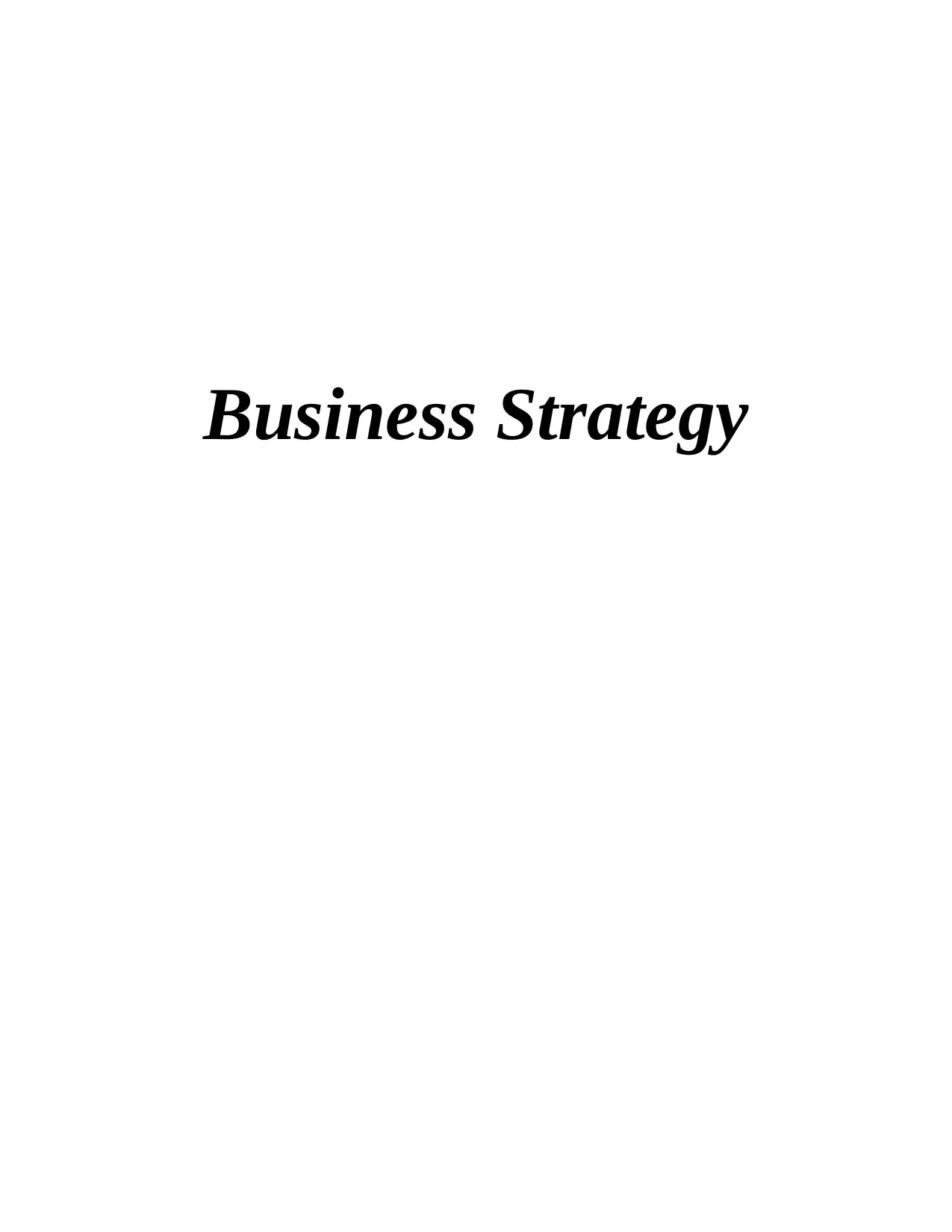
Business Strategy
Paraphrase This Document
Need a fresh take? Get an instant paraphrase of this document with our AI Paraphraser
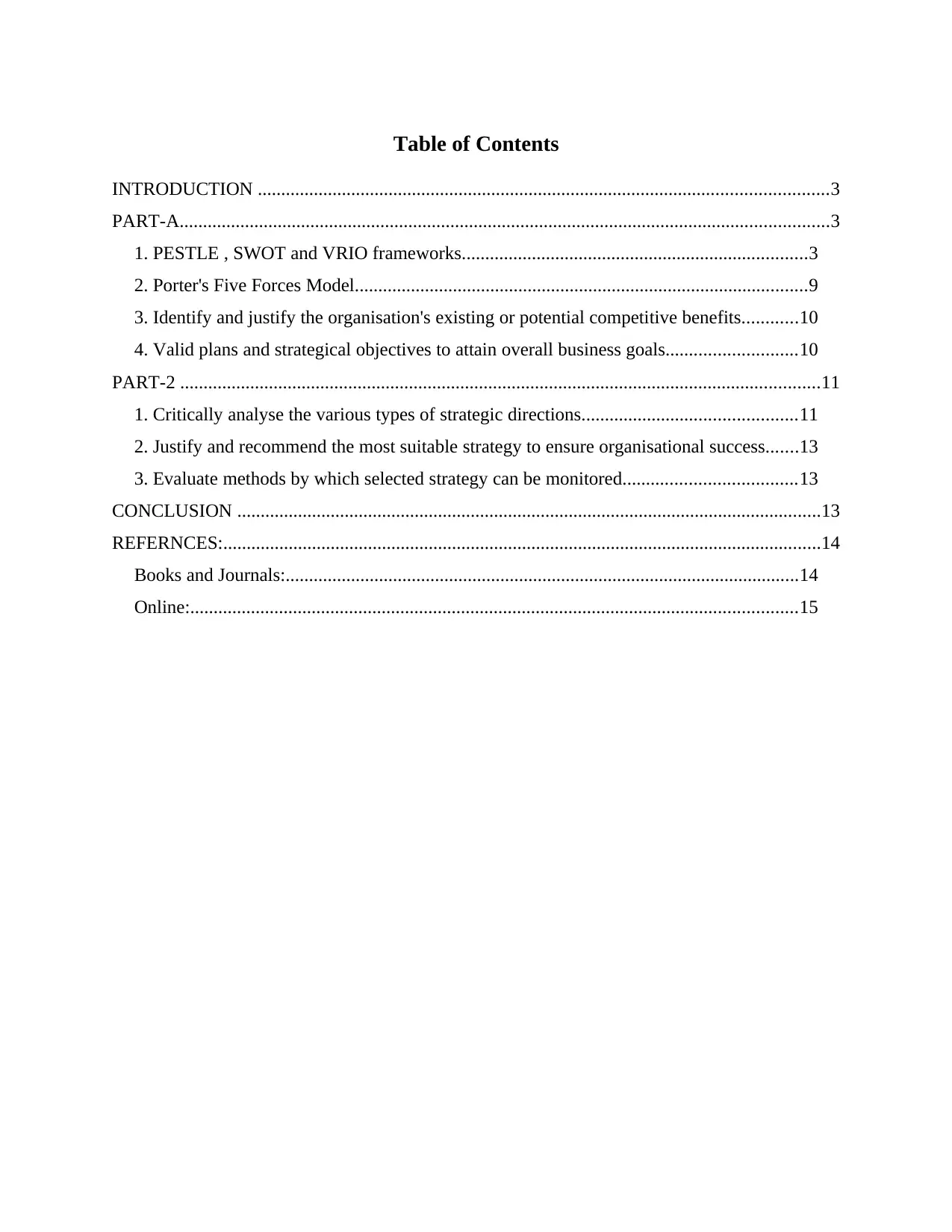
Table of Contents
INTRODUCTION ..........................................................................................................................3
PART-A...........................................................................................................................................3
1. PESTLE , SWOT and VRIO frameworks..........................................................................3
2. Porter's Five Forces Model.................................................................................................9
3. Identify and justify the organisation's existing or potential competitive benefits............10
4. Valid plans and strategical objectives to attain overall business goals............................10
PART-2 .........................................................................................................................................11
1. Critically analyse the various types of strategic directions..............................................11
2. Justify and recommend the most suitable strategy to ensure organisational success.......13
3. Evaluate methods by which selected strategy can be monitored.....................................13
CONCLUSION .............................................................................................................................13
REFERNCES:................................................................................................................................14
Books and Journals:..............................................................................................................14
Online:..................................................................................................................................15
INTRODUCTION ..........................................................................................................................3
PART-A...........................................................................................................................................3
1. PESTLE , SWOT and VRIO frameworks..........................................................................3
2. Porter's Five Forces Model.................................................................................................9
3. Identify and justify the organisation's existing or potential competitive benefits............10
4. Valid plans and strategical objectives to attain overall business goals............................10
PART-2 .........................................................................................................................................11
1. Critically analyse the various types of strategic directions..............................................11
2. Justify and recommend the most suitable strategy to ensure organisational success.......13
3. Evaluate methods by which selected strategy can be monitored.....................................13
CONCLUSION .............................................................................................................................13
REFERNCES:................................................................................................................................14
Books and Journals:..............................................................................................................14
Online:..................................................................................................................................15
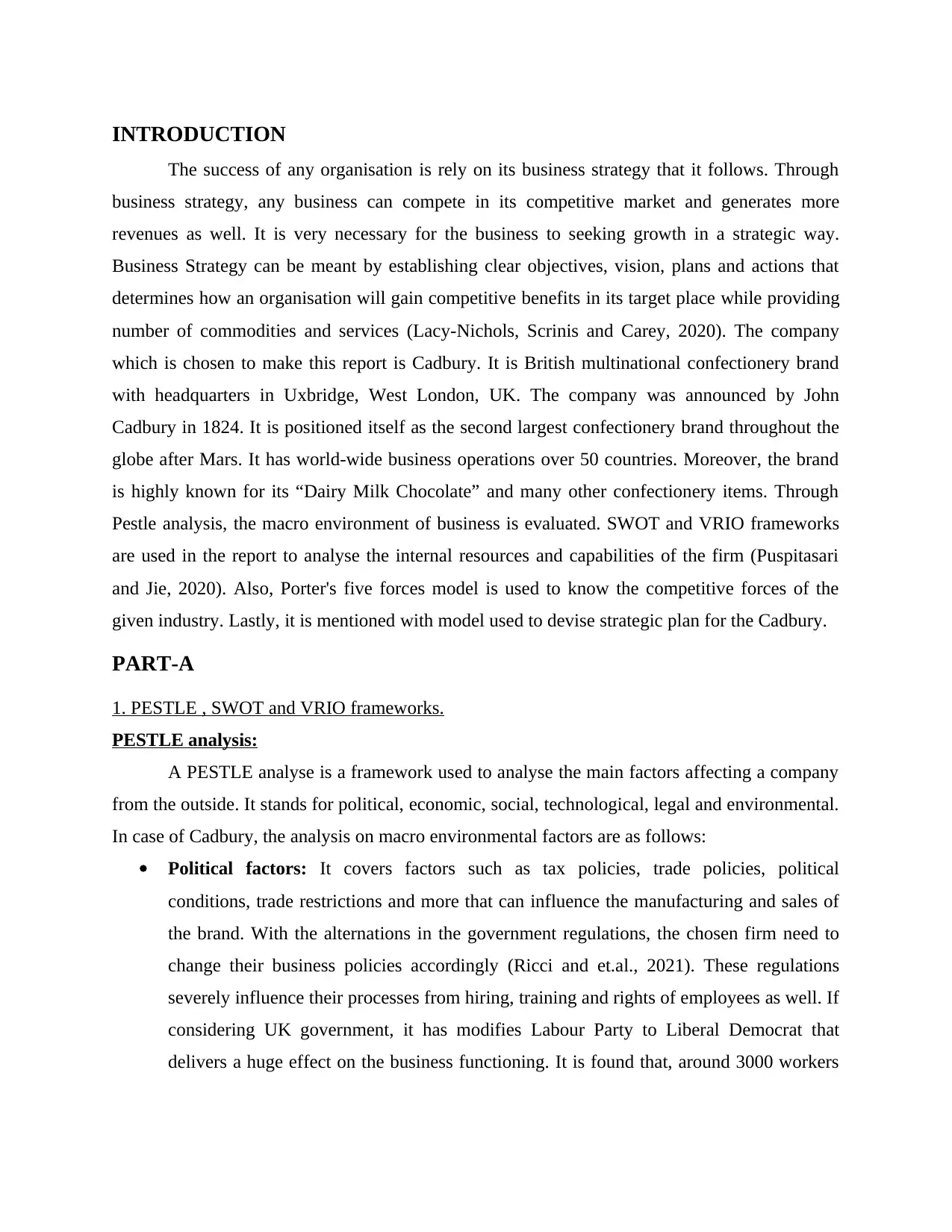
INTRODUCTION
The success of any organisation is rely on its business strategy that it follows. Through
business strategy, any business can compete in its competitive market and generates more
revenues as well. It is very necessary for the business to seeking growth in a strategic way.
Business Strategy can be meant by establishing clear objectives, vision, plans and actions that
determines how an organisation will gain competitive benefits in its target place while providing
number of commodities and services (Lacy-Nichols, Scrinis and Carey, 2020). The company
which is chosen to make this report is Cadbury. It is British multinational confectionery brand
with headquarters in Uxbridge, West London, UK. The company was announced by John
Cadbury in 1824. It is positioned itself as the second largest confectionery brand throughout the
globe after Mars. It has world-wide business operations over 50 countries. Moreover, the brand
is highly known for its “Dairy Milk Chocolate” and many other confectionery items. Through
Pestle analysis, the macro environment of business is evaluated. SWOT and VRIO frameworks
are used in the report to analyse the internal resources and capabilities of the firm (Puspitasari
and Jie, 2020). Also, Porter's five forces model is used to know the competitive forces of the
given industry. Lastly, it is mentioned with model used to devise strategic plan for the Cadbury.
PART-A
1. PESTLE , SWOT and VRIO frameworks.
PESTLE analysis:
A PESTLE analyse is a framework used to analyse the main factors affecting a company
from the outside. It stands for political, economic, social, technological, legal and environmental.
In case of Cadbury, the analysis on macro environmental factors are as follows:
Political factors: It covers factors such as tax policies, trade policies, political
conditions, trade restrictions and more that can influence the manufacturing and sales of
the brand. With the alternations in the government regulations, the chosen firm need to
change their business policies accordingly (Ricci and et.al., 2021). These regulations
severely influence their processes from hiring, training and rights of employees as well. If
considering UK government, it has modifies Labour Party to Liberal Democrat that
delivers a huge effect on the business functioning. It is found that, around 3000 workers
The success of any organisation is rely on its business strategy that it follows. Through
business strategy, any business can compete in its competitive market and generates more
revenues as well. It is very necessary for the business to seeking growth in a strategic way.
Business Strategy can be meant by establishing clear objectives, vision, plans and actions that
determines how an organisation will gain competitive benefits in its target place while providing
number of commodities and services (Lacy-Nichols, Scrinis and Carey, 2020). The company
which is chosen to make this report is Cadbury. It is British multinational confectionery brand
with headquarters in Uxbridge, West London, UK. The company was announced by John
Cadbury in 1824. It is positioned itself as the second largest confectionery brand throughout the
globe after Mars. It has world-wide business operations over 50 countries. Moreover, the brand
is highly known for its “Dairy Milk Chocolate” and many other confectionery items. Through
Pestle analysis, the macro environment of business is evaluated. SWOT and VRIO frameworks
are used in the report to analyse the internal resources and capabilities of the firm (Puspitasari
and Jie, 2020). Also, Porter's five forces model is used to know the competitive forces of the
given industry. Lastly, it is mentioned with model used to devise strategic plan for the Cadbury.
PART-A
1. PESTLE , SWOT and VRIO frameworks.
PESTLE analysis:
A PESTLE analyse is a framework used to analyse the main factors affecting a company
from the outside. It stands for political, economic, social, technological, legal and environmental.
In case of Cadbury, the analysis on macro environmental factors are as follows:
Political factors: It covers factors such as tax policies, trade policies, political
conditions, trade restrictions and more that can influence the manufacturing and sales of
the brand. With the alternations in the government regulations, the chosen firm need to
change their business policies accordingly (Ricci and et.al., 2021). These regulations
severely influence their processes from hiring, training and rights of employees as well. If
considering UK government, it has modifies Labour Party to Liberal Democrat that
delivers a huge effect on the business functioning. It is found that, around 3000 workers
⊘ This is a preview!⊘
Do you want full access?
Subscribe today to unlock all pages.

Trusted by 1+ million students worldwide
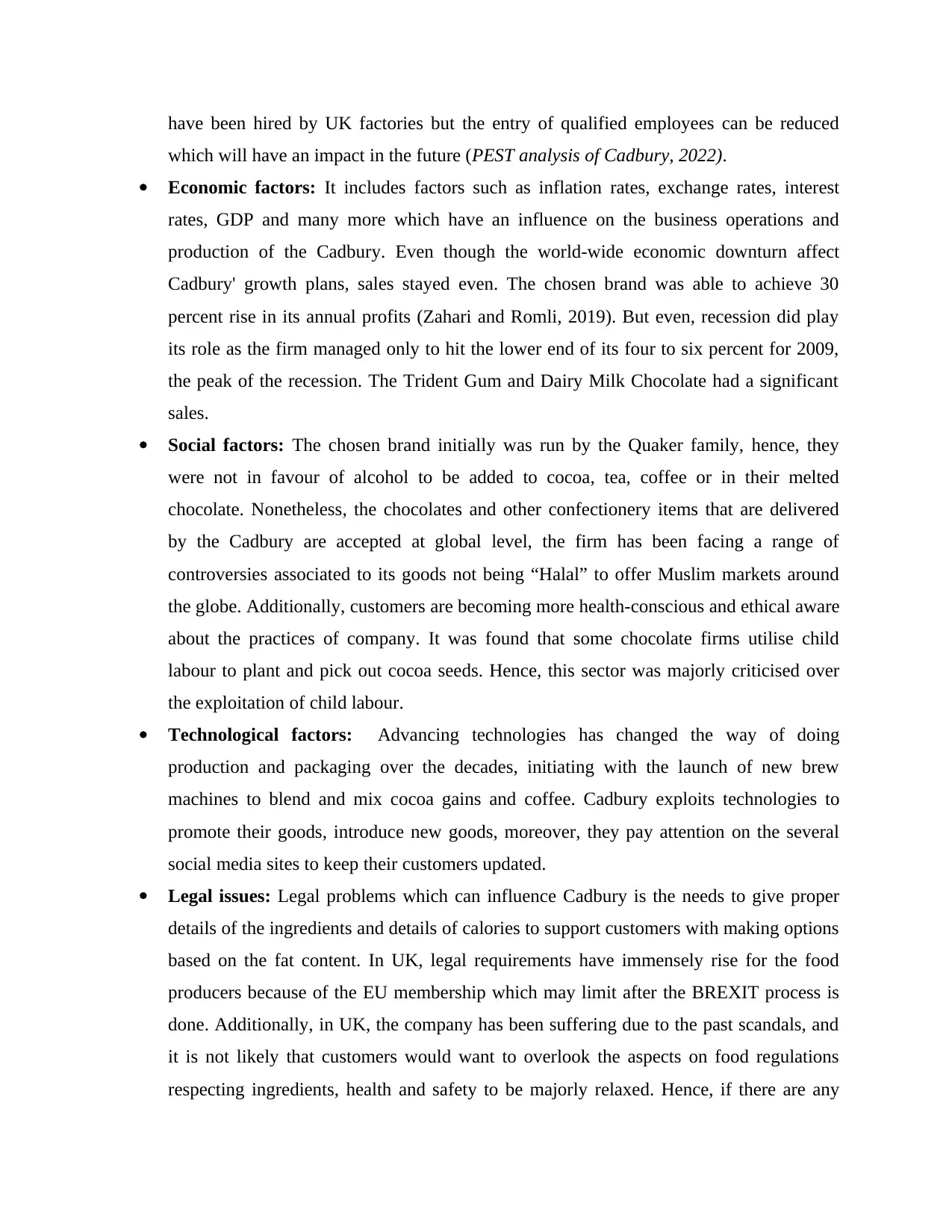
have been hired by UK factories but the entry of qualified employees can be reduced
which will have an impact in the future (PEST analysis of Cadbury, 2022).
Economic factors: It includes factors such as inflation rates, exchange rates, interest
rates, GDP and many more which have an influence on the business operations and
production of the Cadbury. Even though the world-wide economic downturn affect
Cadbury' growth plans, sales stayed even. The chosen brand was able to achieve 30
percent rise in its annual profits (Zahari and Romli, 2019). But even, recession did play
its role as the firm managed only to hit the lower end of its four to six percent for 2009,
the peak of the recession. The Trident Gum and Dairy Milk Chocolate had a significant
sales.
Social factors: The chosen brand initially was run by the Quaker family, hence, they
were not in favour of alcohol to be added to cocoa, tea, coffee or in their melted
chocolate. Nonetheless, the chocolates and other confectionery items that are delivered
by the Cadbury are accepted at global level, the firm has been facing a range of
controversies associated to its goods not being “Halal” to offer Muslim markets around
the globe. Additionally, customers are becoming more health-conscious and ethical aware
about the practices of company. It was found that some chocolate firms utilise child
labour to plant and pick out cocoa seeds. Hence, this sector was majorly criticised over
the exploitation of child labour.
Technological factors: Advancing technologies has changed the way of doing
production and packaging over the decades, initiating with the launch of new brew
machines to blend and mix cocoa gains and coffee. Cadbury exploits technologies to
promote their goods, introduce new goods, moreover, they pay attention on the several
social media sites to keep their customers updated.
Legal issues: Legal problems which can influence Cadbury is the needs to give proper
details of the ingredients and details of calories to support customers with making options
based on the fat content. In UK, legal requirements have immensely rise for the food
producers because of the EU membership which may limit after the BREXIT process is
done. Additionally, in UK, the company has been suffering due to the past scandals, and
it is not likely that customers would want to overlook the aspects on food regulations
respecting ingredients, health and safety to be majorly relaxed. Hence, if there are any
which will have an impact in the future (PEST analysis of Cadbury, 2022).
Economic factors: It includes factors such as inflation rates, exchange rates, interest
rates, GDP and many more which have an influence on the business operations and
production of the Cadbury. Even though the world-wide economic downturn affect
Cadbury' growth plans, sales stayed even. The chosen brand was able to achieve 30
percent rise in its annual profits (Zahari and Romli, 2019). But even, recession did play
its role as the firm managed only to hit the lower end of its four to six percent for 2009,
the peak of the recession. The Trident Gum and Dairy Milk Chocolate had a significant
sales.
Social factors: The chosen brand initially was run by the Quaker family, hence, they
were not in favour of alcohol to be added to cocoa, tea, coffee or in their melted
chocolate. Nonetheless, the chocolates and other confectionery items that are delivered
by the Cadbury are accepted at global level, the firm has been facing a range of
controversies associated to its goods not being “Halal” to offer Muslim markets around
the globe. Additionally, customers are becoming more health-conscious and ethical aware
about the practices of company. It was found that some chocolate firms utilise child
labour to plant and pick out cocoa seeds. Hence, this sector was majorly criticised over
the exploitation of child labour.
Technological factors: Advancing technologies has changed the way of doing
production and packaging over the decades, initiating with the launch of new brew
machines to blend and mix cocoa gains and coffee. Cadbury exploits technologies to
promote their goods, introduce new goods, moreover, they pay attention on the several
social media sites to keep their customers updated.
Legal issues: Legal problems which can influence Cadbury is the needs to give proper
details of the ingredients and details of calories to support customers with making options
based on the fat content. In UK, legal requirements have immensely rise for the food
producers because of the EU membership which may limit after the BREXIT process is
done. Additionally, in UK, the company has been suffering due to the past scandals, and
it is not likely that customers would want to overlook the aspects on food regulations
respecting ingredients, health and safety to be majorly relaxed. Hence, if there are any
Paraphrase This Document
Need a fresh take? Get an instant paraphrase of this document with our AI Paraphraser

legal implications for usage of contents in confectionery items, it may impact brand in a
lot of manners.
Environmental factors: It is one of the main concerns that impacts all sorts of
companies. Fossil fuels are exploited in bigger amounts which rises the costs of
operations. Hence, there may need of alternatives related to it. Cadbury is required to
improve its brand image by investing in Green Technologies i.e. eco-friendly process.
The environmental factor involves the concerns related with the amount of packaging.
Also, the brand has limit its utilization of Easter eggs (Kim,Rim and Lee, 2019). Another
issue will link to carbon footprint developed by their SCM involving production and
distribution. In case of Cadbury, the brand can supports growers who plant and pick
cocoa beans to make sure that this functions in sustainable way.
SWOT analysis:
It is a proven management tool to analyse the strengths, weaknesses, opportunities and
threats of an organisation. In case of Cadbury Company, this tool enables the business to
benchmark its performance and business as compared to the rivalries. The SWOT analysis of
Cadbury is mentioned underneath:
Strengths of Cadbury:
World leader: Cadbury positioned itself as the world's leader in the confectionery
business. Recognized to have the best manufacturing and distribution modes. Cadbury
exists in more than 160 countries.
Brand name, brand equity and brand loyalty: The products of chosen confectionery
brand are blessed with a great brand loyalty (Hajizadeh, 2019). The brand uses extensive
marketing strategies over the years, the brand equity is also high. Therefore, it also
charges premium prices for its items due to high brand equity.
Powerhouse brands and products: Cadbury has variety of strong brands in its product
line such as Bournvita, Five Star, Dairy Milk, Orea and many more. All such goods are of
high quality and some of the, are Cash Cows for the chosen brand.
Promotions: With a great tag line of “TASTE LIKE IT FEELS” along with ATL and
BTL initiatives, the brand has one of the powerful promotions in the sector.
lot of manners.
Environmental factors: It is one of the main concerns that impacts all sorts of
companies. Fossil fuels are exploited in bigger amounts which rises the costs of
operations. Hence, there may need of alternatives related to it. Cadbury is required to
improve its brand image by investing in Green Technologies i.e. eco-friendly process.
The environmental factor involves the concerns related with the amount of packaging.
Also, the brand has limit its utilization of Easter eggs (Kim,Rim and Lee, 2019). Another
issue will link to carbon footprint developed by their SCM involving production and
distribution. In case of Cadbury, the brand can supports growers who plant and pick
cocoa beans to make sure that this functions in sustainable way.
SWOT analysis:
It is a proven management tool to analyse the strengths, weaknesses, opportunities and
threats of an organisation. In case of Cadbury Company, this tool enables the business to
benchmark its performance and business as compared to the rivalries. The SWOT analysis of
Cadbury is mentioned underneath:
Strengths of Cadbury:
World leader: Cadbury positioned itself as the world's leader in the confectionery
business. Recognized to have the best manufacturing and distribution modes. Cadbury
exists in more than 160 countries.
Brand name, brand equity and brand loyalty: The products of chosen confectionery
brand are blessed with a great brand loyalty (Hajizadeh, 2019). The brand uses extensive
marketing strategies over the years, the brand equity is also high. Therefore, it also
charges premium prices for its items due to high brand equity.
Powerhouse brands and products: Cadbury has variety of strong brands in its product
line such as Bournvita, Five Star, Dairy Milk, Orea and many more. All such goods are of
high quality and some of the, are Cash Cows for the chosen brand.
Promotions: With a great tag line of “TASTE LIKE IT FEELS” along with ATL and
BTL initiatives, the brand has one of the powerful promotions in the sector.
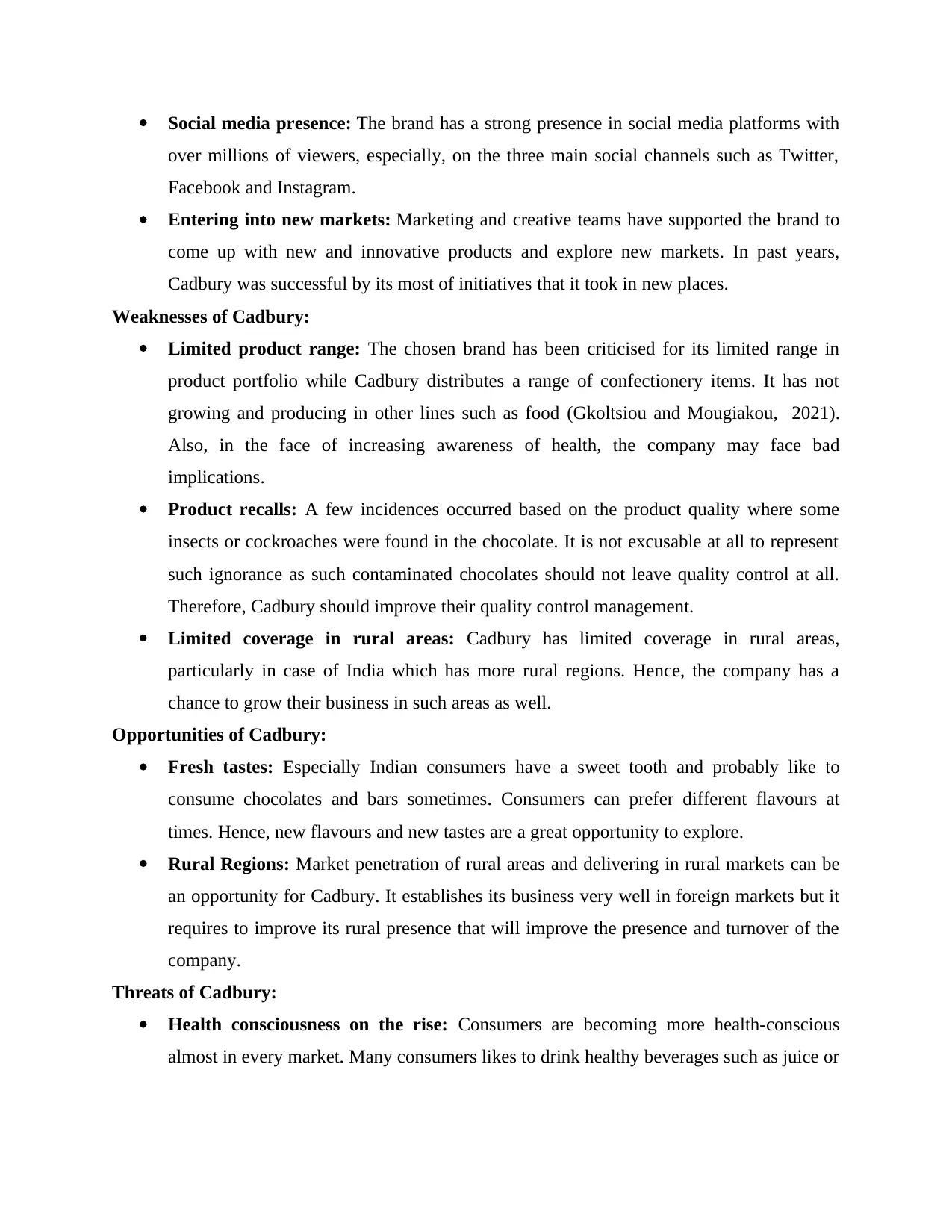
Social media presence: The brand has a strong presence in social media platforms with
over millions of viewers, especially, on the three main social channels such as Twitter,
Facebook and Instagram.
Entering into new markets: Marketing and creative teams have supported the brand to
come up with new and innovative products and explore new markets. In past years,
Cadbury was successful by its most of initiatives that it took in new places.
Weaknesses of Cadbury:
Limited product range: The chosen brand has been criticised for its limited range in
product portfolio while Cadbury distributes a range of confectionery items. It has not
growing and producing in other lines such as food (Gkoltsiou and Mougiakou, 2021).
Also, in the face of increasing awareness of health, the company may face bad
implications.
Product recalls: A few incidences occurred based on the product quality where some
insects or cockroaches were found in the chocolate. It is not excusable at all to represent
such ignorance as such contaminated chocolates should not leave quality control at all.
Therefore, Cadbury should improve their quality control management.
Limited coverage in rural areas: Cadbury has limited coverage in rural areas,
particularly in case of India which has more rural regions. Hence, the company has a
chance to grow their business in such areas as well.
Opportunities of Cadbury:
Fresh tastes: Especially Indian consumers have a sweet tooth and probably like to
consume chocolates and bars sometimes. Consumers can prefer different flavours at
times. Hence, new flavours and new tastes are a great opportunity to explore.
Rural Regions: Market penetration of rural areas and delivering in rural markets can be
an opportunity for Cadbury. It establishes its business very well in foreign markets but it
requires to improve its rural presence that will improve the presence and turnover of the
company.
Threats of Cadbury:
Health consciousness on the rise: Consumers are becoming more health-conscious
almost in every market. Many consumers likes to drink healthy beverages such as juice or
over millions of viewers, especially, on the three main social channels such as Twitter,
Facebook and Instagram.
Entering into new markets: Marketing and creative teams have supported the brand to
come up with new and innovative products and explore new markets. In past years,
Cadbury was successful by its most of initiatives that it took in new places.
Weaknesses of Cadbury:
Limited product range: The chosen brand has been criticised for its limited range in
product portfolio while Cadbury distributes a range of confectionery items. It has not
growing and producing in other lines such as food (Gkoltsiou and Mougiakou, 2021).
Also, in the face of increasing awareness of health, the company may face bad
implications.
Product recalls: A few incidences occurred based on the product quality where some
insects or cockroaches were found in the chocolate. It is not excusable at all to represent
such ignorance as such contaminated chocolates should not leave quality control at all.
Therefore, Cadbury should improve their quality control management.
Limited coverage in rural areas: Cadbury has limited coverage in rural areas,
particularly in case of India which has more rural regions. Hence, the company has a
chance to grow their business in such areas as well.
Opportunities of Cadbury:
Fresh tastes: Especially Indian consumers have a sweet tooth and probably like to
consume chocolates and bars sometimes. Consumers can prefer different flavours at
times. Hence, new flavours and new tastes are a great opportunity to explore.
Rural Regions: Market penetration of rural areas and delivering in rural markets can be
an opportunity for Cadbury. It establishes its business very well in foreign markets but it
requires to improve its rural presence that will improve the presence and turnover of the
company.
Threats of Cadbury:
Health consciousness on the rise: Consumers are becoming more health-conscious
almost in every market. Many consumers likes to drink healthy beverages such as juice or
⊘ This is a preview!⊘
Do you want full access?
Subscribe today to unlock all pages.

Trusted by 1+ million students worldwide
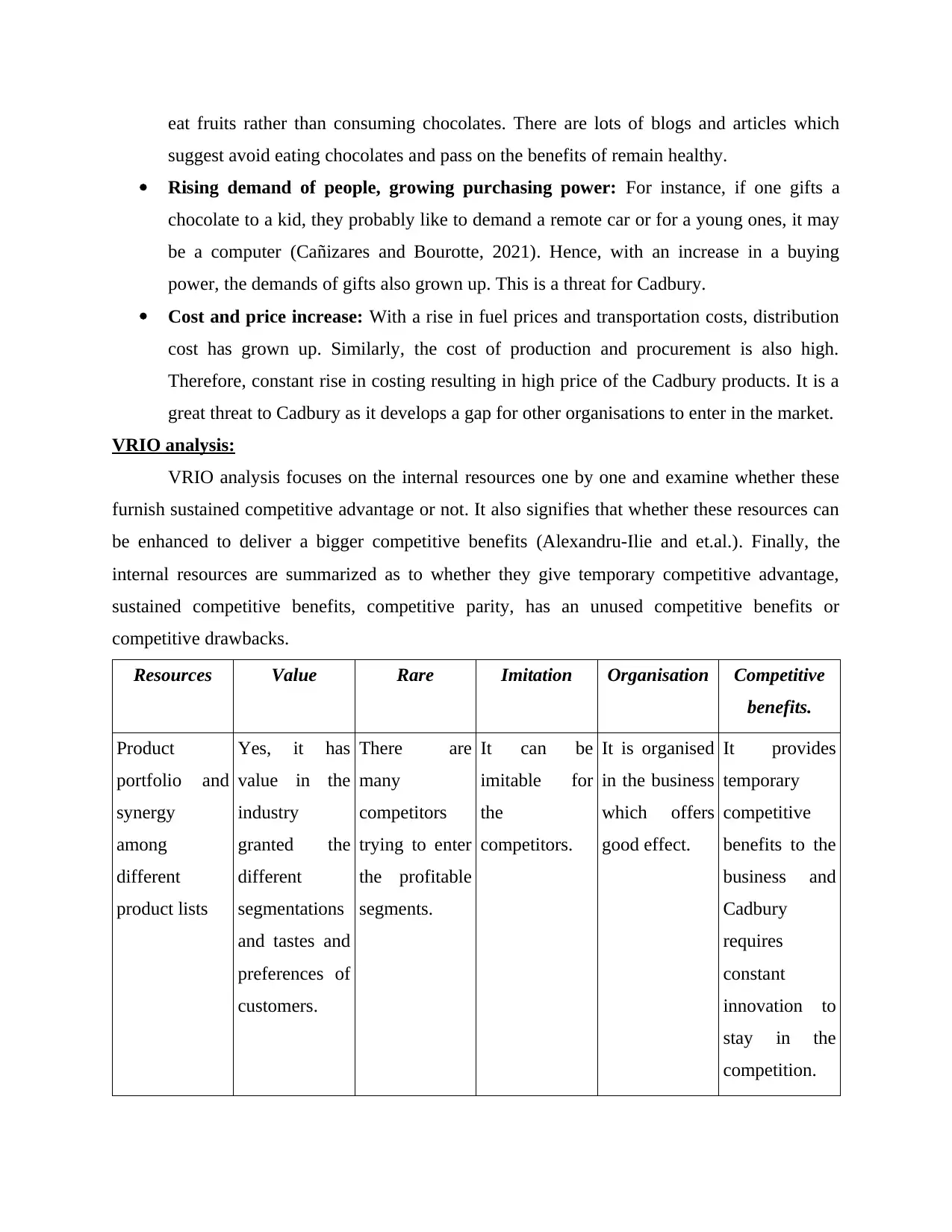
eat fruits rather than consuming chocolates. There are lots of blogs and articles which
suggest avoid eating chocolates and pass on the benefits of remain healthy.
Rising demand of people, growing purchasing power: For instance, if one gifts a
chocolate to a kid, they probably like to demand a remote car or for a young ones, it may
be a computer (Cañizares and Bourotte, 2021). Hence, with an increase in a buying
power, the demands of gifts also grown up. This is a threat for Cadbury.
Cost and price increase: With a rise in fuel prices and transportation costs, distribution
cost has grown up. Similarly, the cost of production and procurement is also high.
Therefore, constant rise in costing resulting in high price of the Cadbury products. It is a
great threat to Cadbury as it develops a gap for other organisations to enter in the market.
VRIO analysis:
VRIO analysis focuses on the internal resources one by one and examine whether these
furnish sustained competitive advantage or not. It also signifies that whether these resources can
be enhanced to deliver a bigger competitive benefits (Alexandru-Ilie and et.al.). Finally, the
internal resources are summarized as to whether they give temporary competitive advantage,
sustained competitive benefits, competitive parity, has an unused competitive benefits or
competitive drawbacks.
Resources Value Rare Imitation Organisation Competitive
benefits.
Product
portfolio and
synergy
among
different
product lists
Yes, it has
value in the
industry
granted the
different
segmentations
and tastes and
preferences of
customers.
There are
many
competitors
trying to enter
the profitable
segments.
It can be
imitable for
the
competitors.
It is organised
in the business
which offers
good effect.
It provides
temporary
competitive
benefits to the
business and
Cadbury
requires
constant
innovation to
stay in the
competition.
suggest avoid eating chocolates and pass on the benefits of remain healthy.
Rising demand of people, growing purchasing power: For instance, if one gifts a
chocolate to a kid, they probably like to demand a remote car or for a young ones, it may
be a computer (Cañizares and Bourotte, 2021). Hence, with an increase in a buying
power, the demands of gifts also grown up. This is a threat for Cadbury.
Cost and price increase: With a rise in fuel prices and transportation costs, distribution
cost has grown up. Similarly, the cost of production and procurement is also high.
Therefore, constant rise in costing resulting in high price of the Cadbury products. It is a
great threat to Cadbury as it develops a gap for other organisations to enter in the market.
VRIO analysis:
VRIO analysis focuses on the internal resources one by one and examine whether these
furnish sustained competitive advantage or not. It also signifies that whether these resources can
be enhanced to deliver a bigger competitive benefits (Alexandru-Ilie and et.al.). Finally, the
internal resources are summarized as to whether they give temporary competitive advantage,
sustained competitive benefits, competitive parity, has an unused competitive benefits or
competitive drawbacks.
Resources Value Rare Imitation Organisation Competitive
benefits.
Product
portfolio and
synergy
among
different
product lists
Yes, it has
value in the
industry
granted the
different
segmentations
and tastes and
preferences of
customers.
There are
many
competitors
trying to enter
the profitable
segments.
It can be
imitable for
the
competitors.
It is organised
in the business
which offers
good effect.
It provides
temporary
competitive
benefits to the
business and
Cadbury
requires
constant
innovation to
stay in the
competition.
Paraphrase This Document
Need a fresh take? Get an instant paraphrase of this document with our AI Paraphraser
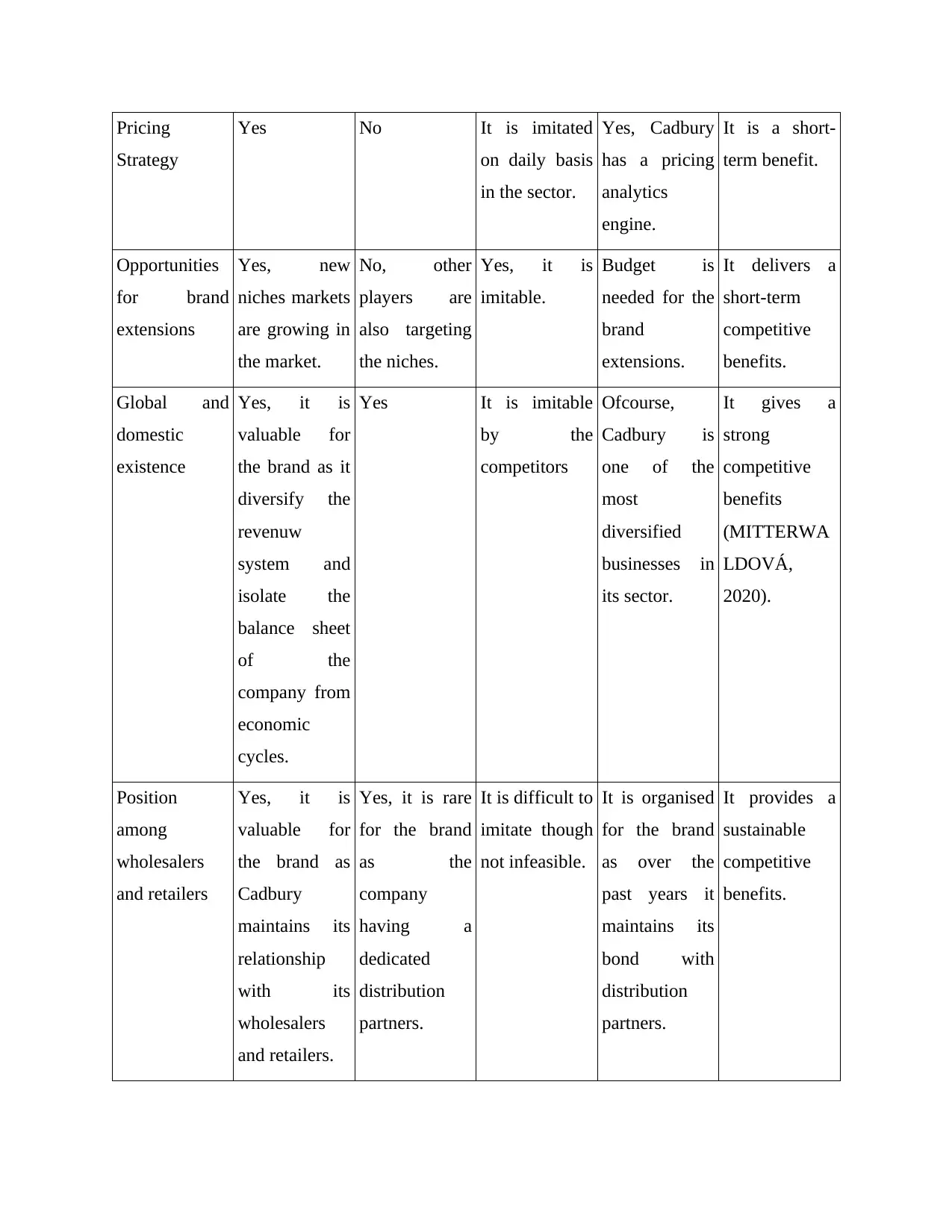
Pricing
Strategy
Yes No It is imitated
on daily basis
in the sector.
Yes, Cadbury
has a pricing
analytics
engine.
It is a short-
term benefit.
Opportunities
for brand
extensions
Yes, new
niches markets
are growing in
the market.
No, other
players are
also targeting
the niches.
Yes, it is
imitable.
Budget is
needed for the
brand
extensions.
It delivers a
short-term
competitive
benefits.
Global and
domestic
existence
Yes, it is
valuable for
the brand as it
diversify the
revenuw
system and
isolate the
balance sheet
of the
company from
economic
cycles.
Yes It is imitable
by the
competitors
Ofcourse,
Cadbury is
one of the
most
diversified
businesses in
its sector.
It gives a
strong
competitive
benefits
(MITTERWA
LDOVÁ,
2020).
Position
among
wholesalers
and retailers
Yes, it is
valuable for
the brand as
Cadbury
maintains its
relationship
with its
wholesalers
and retailers.
Yes, it is rare
for the brand
as the
company
having a
dedicated
distribution
partners.
It is difficult to
imitate though
not infeasible.
It is organised
for the brand
as over the
past years it
maintains its
bond with
distribution
partners.
It provides a
sustainable
competitive
benefits.
Strategy
Yes No It is imitated
on daily basis
in the sector.
Yes, Cadbury
has a pricing
analytics
engine.
It is a short-
term benefit.
Opportunities
for brand
extensions
Yes, new
niches markets
are growing in
the market.
No, other
players are
also targeting
the niches.
Yes, it is
imitable.
Budget is
needed for the
brand
extensions.
It delivers a
short-term
competitive
benefits.
Global and
domestic
existence
Yes, it is
valuable for
the brand as it
diversify the
revenuw
system and
isolate the
balance sheet
of the
company from
economic
cycles.
Yes It is imitable
by the
competitors
Ofcourse,
Cadbury is
one of the
most
diversified
businesses in
its sector.
It gives a
strong
competitive
benefits
(MITTERWA
LDOVÁ,
2020).
Position
among
wholesalers
and retailers
Yes, it is
valuable for
the brand as
Cadbury
maintains its
relationship
with its
wholesalers
and retailers.
Yes, it is rare
for the brand
as the
company
having a
dedicated
distribution
partners.
It is difficult to
imitate though
not infeasible.
It is organised
for the brand
as over the
past years it
maintains its
bond with
distribution
partners.
It provides a
sustainable
competitive
benefits.
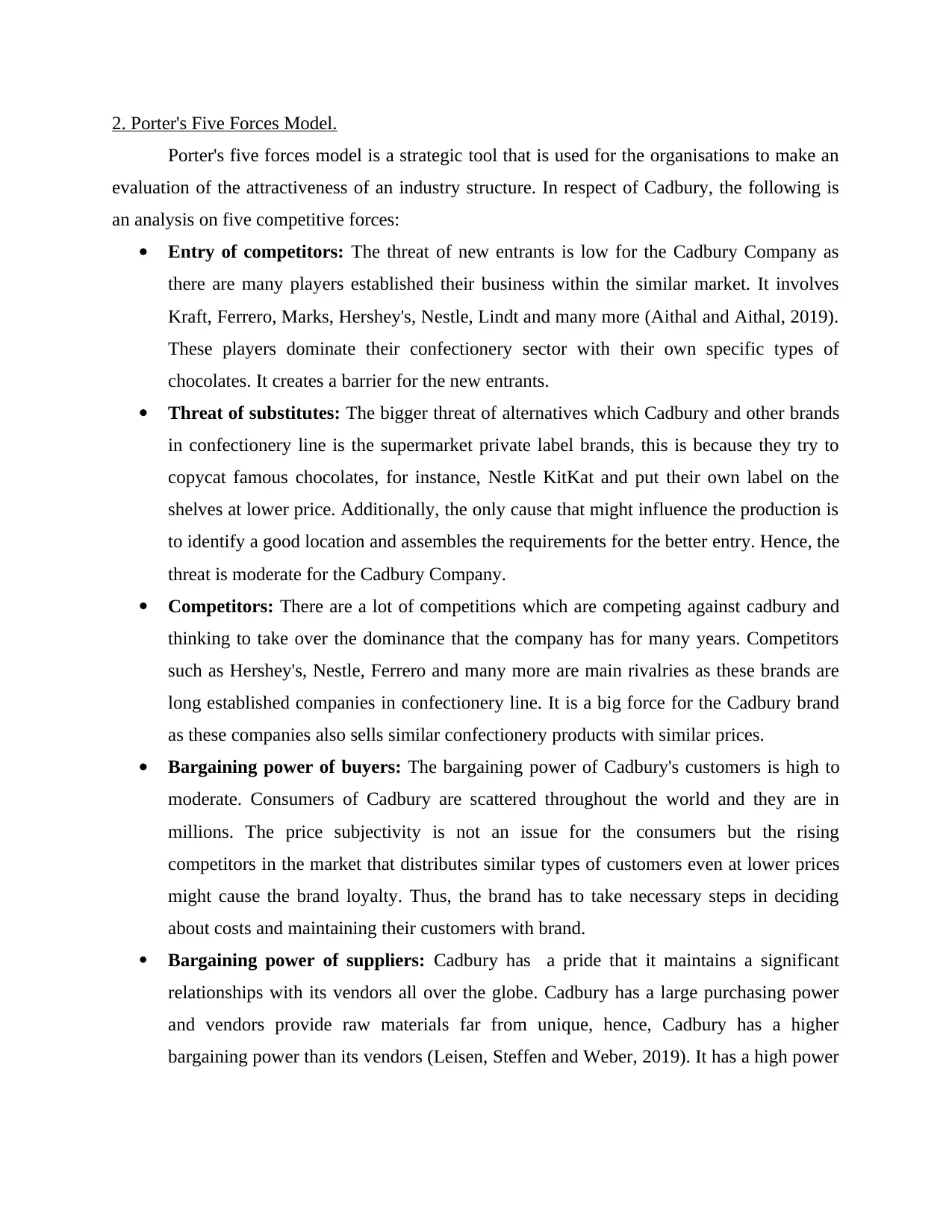
2. Porter's Five Forces Model.
Porter's five forces model is a strategic tool that is used for the organisations to make an
evaluation of the attractiveness of an industry structure. In respect of Cadbury, the following is
an analysis on five competitive forces:
Entry of competitors: The threat of new entrants is low for the Cadbury Company as
there are many players established their business within the similar market. It involves
Kraft, Ferrero, Marks, Hershey's, Nestle, Lindt and many more (Aithal and Aithal, 2019).
These players dominate their confectionery sector with their own specific types of
chocolates. It creates a barrier for the new entrants.
Threat of substitutes: The bigger threat of alternatives which Cadbury and other brands
in confectionery line is the supermarket private label brands, this is because they try to
copycat famous chocolates, for instance, Nestle KitKat and put their own label on the
shelves at lower price. Additionally, the only cause that might influence the production is
to identify a good location and assembles the requirements for the better entry. Hence, the
threat is moderate for the Cadbury Company.
Competitors: There are a lot of competitions which are competing against cadbury and
thinking to take over the dominance that the company has for many years. Competitors
such as Hershey's, Nestle, Ferrero and many more are main rivalries as these brands are
long established companies in confectionery line. It is a big force for the Cadbury brand
as these companies also sells similar confectionery products with similar prices.
Bargaining power of buyers: The bargaining power of Cadbury's customers is high to
moderate. Consumers of Cadbury are scattered throughout the world and they are in
millions. The price subjectivity is not an issue for the consumers but the rising
competitors in the market that distributes similar types of customers even at lower prices
might cause the brand loyalty. Thus, the brand has to take necessary steps in deciding
about costs and maintaining their customers with brand.
Bargaining power of suppliers: Cadbury has a pride that it maintains a significant
relationships with its vendors all over the globe. Cadbury has a large purchasing power
and vendors provide raw materials far from unique, hence, Cadbury has a higher
bargaining power than its vendors (Leisen, Steffen and Weber, 2019). It has a high power
Porter's five forces model is a strategic tool that is used for the organisations to make an
evaluation of the attractiveness of an industry structure. In respect of Cadbury, the following is
an analysis on five competitive forces:
Entry of competitors: The threat of new entrants is low for the Cadbury Company as
there are many players established their business within the similar market. It involves
Kraft, Ferrero, Marks, Hershey's, Nestle, Lindt and many more (Aithal and Aithal, 2019).
These players dominate their confectionery sector with their own specific types of
chocolates. It creates a barrier for the new entrants.
Threat of substitutes: The bigger threat of alternatives which Cadbury and other brands
in confectionery line is the supermarket private label brands, this is because they try to
copycat famous chocolates, for instance, Nestle KitKat and put their own label on the
shelves at lower price. Additionally, the only cause that might influence the production is
to identify a good location and assembles the requirements for the better entry. Hence, the
threat is moderate for the Cadbury Company.
Competitors: There are a lot of competitions which are competing against cadbury and
thinking to take over the dominance that the company has for many years. Competitors
such as Hershey's, Nestle, Ferrero and many more are main rivalries as these brands are
long established companies in confectionery line. It is a big force for the Cadbury brand
as these companies also sells similar confectionery products with similar prices.
Bargaining power of buyers: The bargaining power of Cadbury's customers is high to
moderate. Consumers of Cadbury are scattered throughout the world and they are in
millions. The price subjectivity is not an issue for the consumers but the rising
competitors in the market that distributes similar types of customers even at lower prices
might cause the brand loyalty. Thus, the brand has to take necessary steps in deciding
about costs and maintaining their customers with brand.
Bargaining power of suppliers: Cadbury has a pride that it maintains a significant
relationships with its vendors all over the globe. Cadbury has a large purchasing power
and vendors provide raw materials far from unique, hence, Cadbury has a higher
bargaining power than its vendors (Leisen, Steffen and Weber, 2019). It has a high power
⊘ This is a preview!⊘
Do you want full access?
Subscribe today to unlock all pages.

Trusted by 1+ million students worldwide
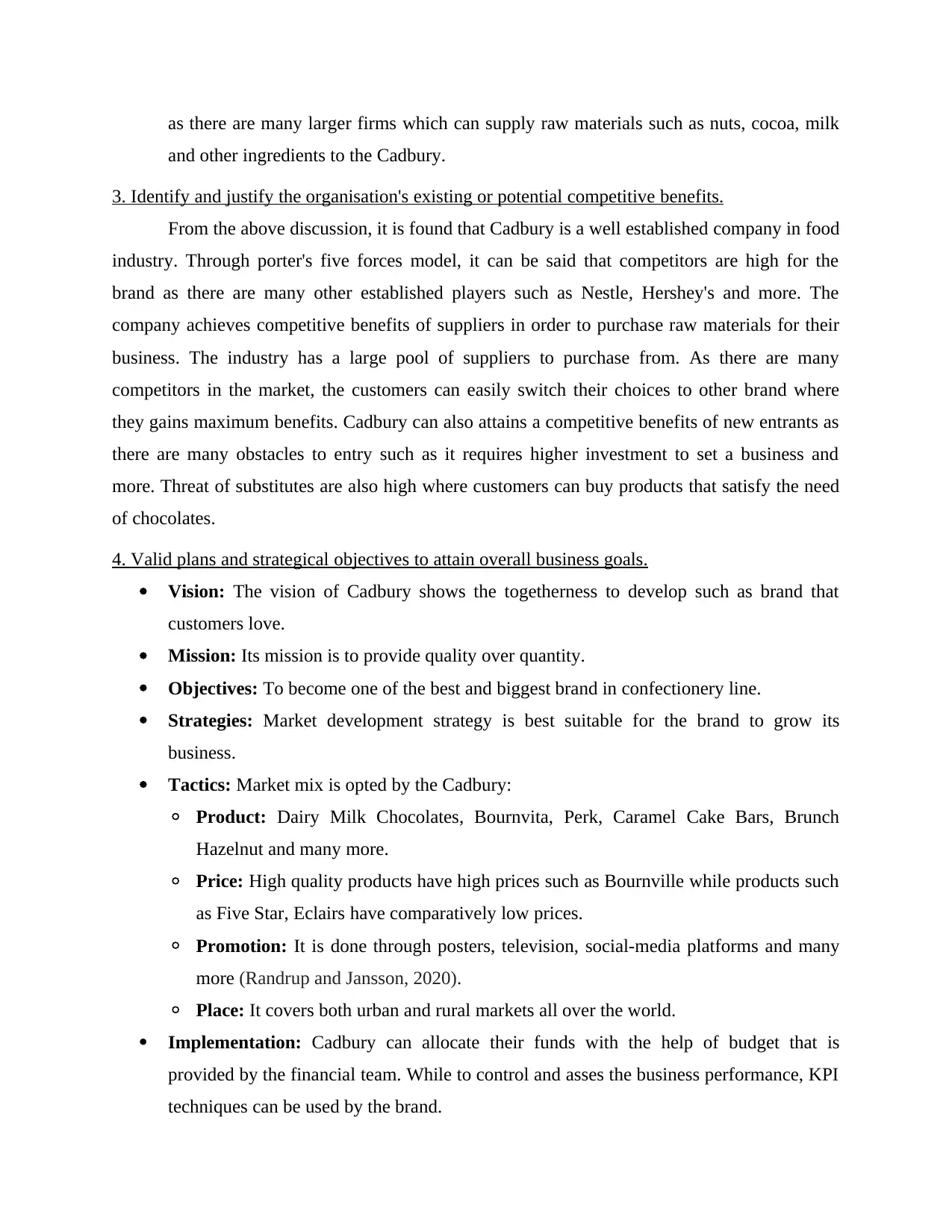
as there are many larger firms which can supply raw materials such as nuts, cocoa, milk
and other ingredients to the Cadbury.
3. Identify and justify the organisation's existing or potential competitive benefits.
From the above discussion, it is found that Cadbury is a well established company in food
industry. Through porter's five forces model, it can be said that competitors are high for the
brand as there are many other established players such as Nestle, Hershey's and more. The
company achieves competitive benefits of suppliers in order to purchase raw materials for their
business. The industry has a large pool of suppliers to purchase from. As there are many
competitors in the market, the customers can easily switch their choices to other brand where
they gains maximum benefits. Cadbury can also attains a competitive benefits of new entrants as
there are many obstacles to entry such as it requires higher investment to set a business and
more. Threat of substitutes are also high where customers can buy products that satisfy the need
of chocolates.
4. Valid plans and strategical objectives to attain overall business goals.
Vision: The vision of Cadbury shows the togetherness to develop such as brand that
customers love.
Mission: Its mission is to provide quality over quantity.
Objectives: To become one of the best and biggest brand in confectionery line.
Strategies: Market development strategy is best suitable for the brand to grow its
business.
Tactics: Market mix is opted by the Cadbury:
◦ Product: Dairy Milk Chocolates, Bournvita, Perk, Caramel Cake Bars, Brunch
Hazelnut and many more.
◦ Price: High quality products have high prices such as Bournville while products such
as Five Star, Eclairs have comparatively low prices.
◦ Promotion: It is done through posters, television, social-media platforms and many
more (Randrup and Jansson, 2020).
◦ Place: It covers both urban and rural markets all over the world.
Implementation: Cadbury can allocate their funds with the help of budget that is
provided by the financial team. While to control and asses the business performance, KPI
techniques can be used by the brand.
and other ingredients to the Cadbury.
3. Identify and justify the organisation's existing or potential competitive benefits.
From the above discussion, it is found that Cadbury is a well established company in food
industry. Through porter's five forces model, it can be said that competitors are high for the
brand as there are many other established players such as Nestle, Hershey's and more. The
company achieves competitive benefits of suppliers in order to purchase raw materials for their
business. The industry has a large pool of suppliers to purchase from. As there are many
competitors in the market, the customers can easily switch their choices to other brand where
they gains maximum benefits. Cadbury can also attains a competitive benefits of new entrants as
there are many obstacles to entry such as it requires higher investment to set a business and
more. Threat of substitutes are also high where customers can buy products that satisfy the need
of chocolates.
4. Valid plans and strategical objectives to attain overall business goals.
Vision: The vision of Cadbury shows the togetherness to develop such as brand that
customers love.
Mission: Its mission is to provide quality over quantity.
Objectives: To become one of the best and biggest brand in confectionery line.
Strategies: Market development strategy is best suitable for the brand to grow its
business.
Tactics: Market mix is opted by the Cadbury:
◦ Product: Dairy Milk Chocolates, Bournvita, Perk, Caramel Cake Bars, Brunch
Hazelnut and many more.
◦ Price: High quality products have high prices such as Bournville while products such
as Five Star, Eclairs have comparatively low prices.
◦ Promotion: It is done through posters, television, social-media platforms and many
more (Randrup and Jansson, 2020).
◦ Place: It covers both urban and rural markets all over the world.
Implementation: Cadbury can allocate their funds with the help of budget that is
provided by the financial team. While to control and asses the business performance, KPI
techniques can be used by the brand.
Paraphrase This Document
Need a fresh take? Get an instant paraphrase of this document with our AI Paraphraser
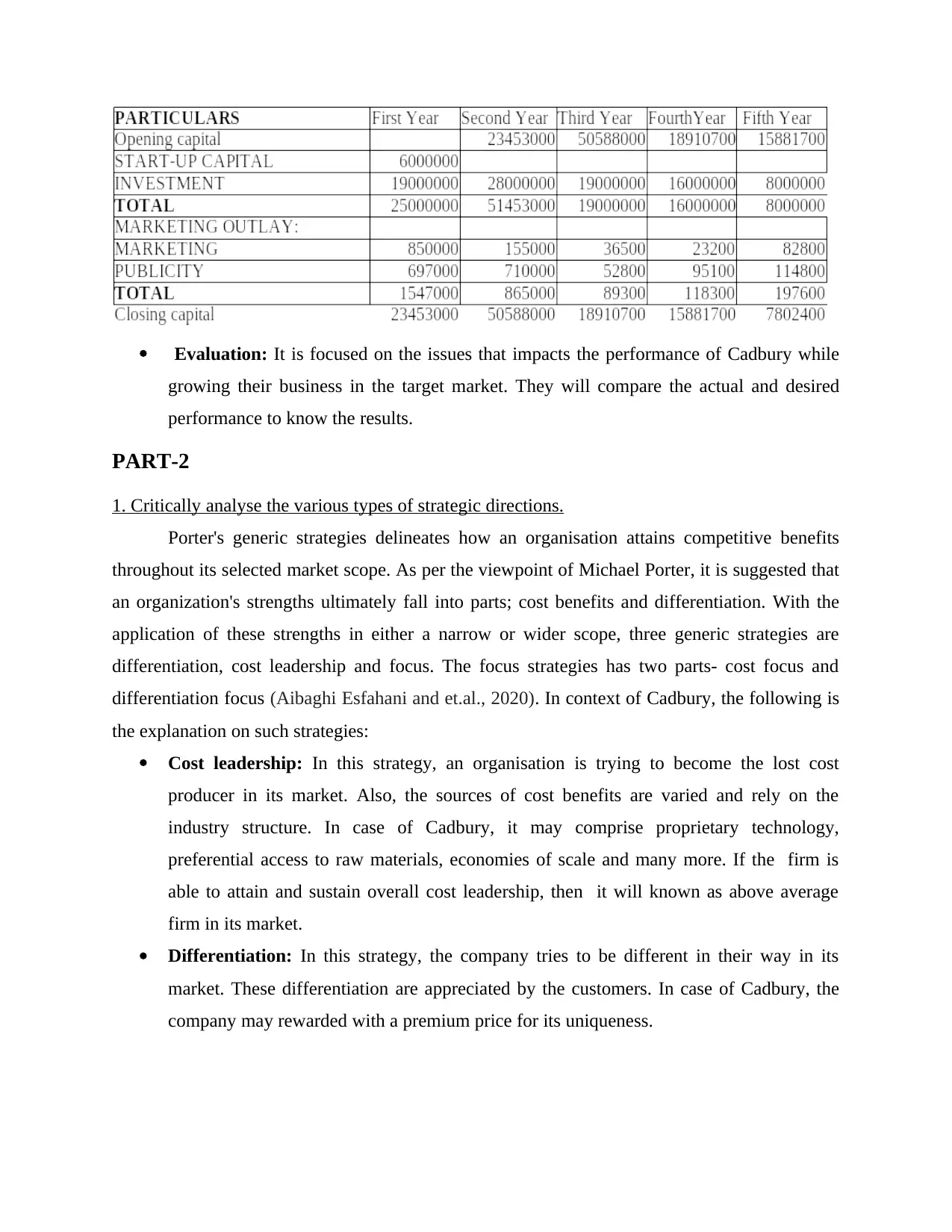
Evaluation: It is focused on the issues that impacts the performance of Cadbury while
growing their business in the target market. They will compare the actual and desired
performance to know the results.
PART-2
1. Critically analyse the various types of strategic directions.
Porter's generic strategies delineates how an organisation attains competitive benefits
throughout its selected market scope. As per the viewpoint of Michael Porter, it is suggested that
an organization's strengths ultimately fall into parts; cost benefits and differentiation. With the
application of these strengths in either a narrow or wider scope, three generic strategies are
differentiation, cost leadership and focus. The focus strategies has two parts- cost focus and
differentiation focus (Aibaghi Esfahani and et.al., 2020). In context of Cadbury, the following is
the explanation on such strategies:
Cost leadership: In this strategy, an organisation is trying to become the lost cost
producer in its market. Also, the sources of cost benefits are varied and rely on the
industry structure. In case of Cadbury, it may comprise proprietary technology,
preferential access to raw materials, economies of scale and many more. If the firm is
able to attain and sustain overall cost leadership, then it will known as above average
firm in its market.
Differentiation: In this strategy, the company tries to be different in their way in its
market. These differentiation are appreciated by the customers. In case of Cadbury, the
company may rewarded with a premium price for its uniqueness.
growing their business in the target market. They will compare the actual and desired
performance to know the results.
PART-2
1. Critically analyse the various types of strategic directions.
Porter's generic strategies delineates how an organisation attains competitive benefits
throughout its selected market scope. As per the viewpoint of Michael Porter, it is suggested that
an organization's strengths ultimately fall into parts; cost benefits and differentiation. With the
application of these strengths in either a narrow or wider scope, three generic strategies are
differentiation, cost leadership and focus. The focus strategies has two parts- cost focus and
differentiation focus (Aibaghi Esfahani and et.al., 2020). In context of Cadbury, the following is
the explanation on such strategies:
Cost leadership: In this strategy, an organisation is trying to become the lost cost
producer in its market. Also, the sources of cost benefits are varied and rely on the
industry structure. In case of Cadbury, it may comprise proprietary technology,
preferential access to raw materials, economies of scale and many more. If the firm is
able to attain and sustain overall cost leadership, then it will known as above average
firm in its market.
Differentiation: In this strategy, the company tries to be different in their way in its
market. These differentiation are appreciated by the customers. In case of Cadbury, the
company may rewarded with a premium price for its uniqueness.

Focus: This kind of generic strategy rests on the selection of a narrow competitive scope
within its market. The focuser opts a segmentation or combination of segments and make
its plan to provide services to the exclusion of others.
◦ In cost focus, a company look for the cost benefits in its target segment.
◦ In differentiation focus, a company looks for its uniqueness to serve into target
segment.
Bowman Strategy's Clock:
This strategy signifies the facets that how a firm can position its goods and services in the
market based on the two categories- in first part, it is about the price, while in second part, it is
perceived value of services, product or the entire company. This strategy shows how Cadbury
can choose its strategic position from that the firm can attain cost benefits. The eight positions of
the Bowman's Strategy Clock is discussed:
Low price and low added value: The price of the company's offering is very low and
the company do not create uniqueness in its offerings while consumers perceives very
little value.
Low price: The company sell their product at low price and leading to low-profit
margins (Helmold, 2020). In this strategy, the firm produces on larger quantity that helps
in the more profit generation.
Hybrid: The uniqueness is put on the firm's offerings that are valued in the target market.
Also, the customers are getting unique products at low prices.
Differentiation: The firm tries to provide high quality products with some differentiation
but the prices are relatively high.
Focused differentiation: It involves luxurious products and exclusive products to be
offered to the customers that are in high-quality and are sold at higher prices.
Risk High Margin: It is very risky strategy and the position of company is probably fair
in the long run. The firm puts high prices for the products that are detected as mediocre in
value by the consumers.
Monopoly Pricing: In this strategy, the company position itself as the monopoly leader
in its target market as they are the only ones who sales the particular kind of product.
within its market. The focuser opts a segmentation or combination of segments and make
its plan to provide services to the exclusion of others.
◦ In cost focus, a company look for the cost benefits in its target segment.
◦ In differentiation focus, a company looks for its uniqueness to serve into target
segment.
Bowman Strategy's Clock:
This strategy signifies the facets that how a firm can position its goods and services in the
market based on the two categories- in first part, it is about the price, while in second part, it is
perceived value of services, product or the entire company. This strategy shows how Cadbury
can choose its strategic position from that the firm can attain cost benefits. The eight positions of
the Bowman's Strategy Clock is discussed:
Low price and low added value: The price of the company's offering is very low and
the company do not create uniqueness in its offerings while consumers perceives very
little value.
Low price: The company sell their product at low price and leading to low-profit
margins (Helmold, 2020). In this strategy, the firm produces on larger quantity that helps
in the more profit generation.
Hybrid: The uniqueness is put on the firm's offerings that are valued in the target market.
Also, the customers are getting unique products at low prices.
Differentiation: The firm tries to provide high quality products with some differentiation
but the prices are relatively high.
Focused differentiation: It involves luxurious products and exclusive products to be
offered to the customers that are in high-quality and are sold at higher prices.
Risk High Margin: It is very risky strategy and the position of company is probably fair
in the long run. The firm puts high prices for the products that are detected as mediocre in
value by the consumers.
Monopoly Pricing: In this strategy, the company position itself as the monopoly leader
in its target market as they are the only ones who sales the particular kind of product.
⊘ This is a preview!⊘
Do you want full access?
Subscribe today to unlock all pages.

Trusted by 1+ million students worldwide
1 out of 15
Related Documents
Your All-in-One AI-Powered Toolkit for Academic Success.
+13062052269
info@desklib.com
Available 24*7 on WhatsApp / Email
![[object Object]](/_next/static/media/star-bottom.7253800d.svg)
Unlock your academic potential
Copyright © 2020–2025 A2Z Services. All Rights Reserved. Developed and managed by ZUCOL.

